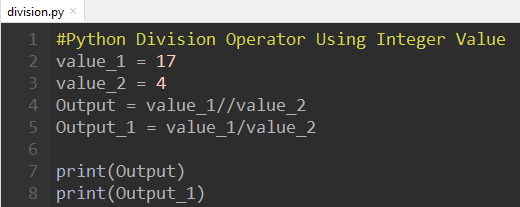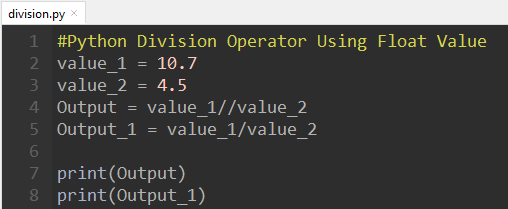Python provides different arithmetic operators that perform certain operations on different data types like integer and float numbers. The division of two numbers provides two values, i.e., the “quotient” value and the “remainder” value. In Python operators, the division operators address the floating point as well as integer values explicitly. This write-up will provide a complete guide on Python Division Operator with suitable examples. The following topics are discussed in detail in this article:
- What are Python Division Operators?
- Example 1: Using Integer Value with Python Division Operator
- Example 2: Using Float Value with Python Division Operator
So let’s begin!
What are Python Division Operators?
Python Division Operators is an arithmetic operator that divides the number and returns the value of the quotient. In Python, two division operators i.e., “/” and “//” are used to divide any integer or a float number. Let’s understand their syntaxes as follows:
Syntaxes
>> x/y
>> x//yThe “/” operator divides the number and returns the value in the “float” data type. The “//” operator divides the number and returns the value in the “integer” data type.
In the upcoming sections, the working of division operators is performed via a few examples.
Example 1: Using Integer Value with Python Division Operator
In this example, integer values are used as input numbers and are divided using the “/” and “//” operator. Let’s see an example of code given below to understand the concept:
Code
#Python Division Operator Using Integer Value
value_1 = 17
value_2 = 4
Output = value_1//value_2
Output_1 = value_1/value_2
print(Output)
print(Output_1)In the above code:
- Two integer variables named “value_1” and “value_2” are initialized.
- The “integer” value returns in the output when the two operand values are divided using the “//” operator.
- The “float” value returns in the output when the two operand values are divided using the “/” operator.

Output

The above output shows the result of two “integer” numbers, Where the “/” operator has returned a whole number, and the “//” operator results in a floating point number.
Example 2: Using Float Value with Python Division Operator
In this example, the float values are used as input numbers and are divided using the “/” and “//” operator. Let’s see an example of code given below to understand the concept:
Code
#Python Division Operator Using Float Value
value_1 = 10.7
value_2 = 4.5
Output = value_1//value_2
Output_1 = value_1/value_2
print(Output)
print(Output_1)In the above code:
- Two float variables named “value_1” and “value_2” are initialized.
- The “//” operator divides the two float values and returns the result in the “float” point without having a remainder value.
- The “float” value, including the “remainder” number, returns in the output when the two float values are divided using the “/” operator.

Output

The above output shows the result of two “float” numbers after division.
That’s all from this informative guide to Python!
Conclusion
In Python, division operators divide two input “float” or “integer” data type numbers using “/” and “//” operators. The “//” operator divides the two numbers and returns the value by terminating the decimal or right side of the number. The “/” operator divides two numbers and returns the result in float data type. This python guide has detailed working and usage of the division operators in Python.

TUTORIALS ON LINUX, PROGRAMMING & TECHNOLOGY